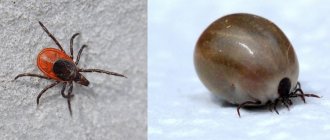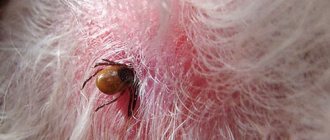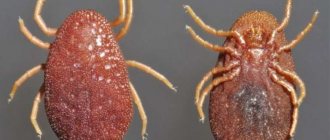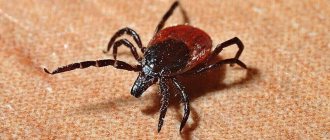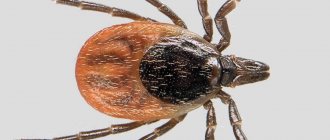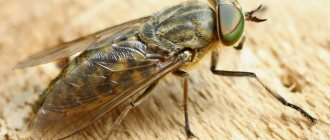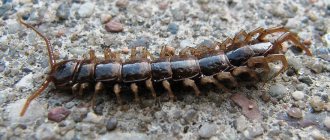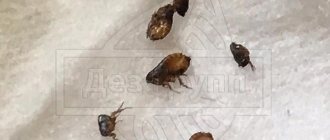The dog was bitten by ticks
Spring, veterinarians warn, is the beginning of the season for the incidence of piroplasmosis, a deadly disease for dogs transmitted by ixodid ticks.
Currently, the disease is recorded throughout almost the entire territory of Russia, where its main carriers are ticks. The territory of Moscow and the Moscow region is also unsafe for piroplasmosis.
Pet owners should take care of prevention, be aware of the signs of disease and first aid measures in case of a tick bite.
Types of ticks
Ticks that parasitize dogs are divided into 2 groups:
- External
- Subcutaneous
Next we will take a closer look at each of these types.
External
In turn, external mites are divided into groups:
Ear mites
Mites in the ear
This mite causes ear scabies, a very common and contagious disease in animals. They are localized mainly on the inside of the ear, less often they migrate to the animal’s head. Ear mites live for two months, outside the animal’s body for up to two weeks.
Ixodid ticks
What does an ixodid tick look like?
Tick fed on blood
They are forest ones. This is the most common species (we will talk about them in more detail) that lives in forests, parks, trees and bushes. Such ticks are dangerous because the animal does not feel the bite due to the secretion secreted by the tick. If the tick is infected, then transmission of the disease is inevitable.
Heyletiella
Cheyletiellosis in a dog
The causative agents are ticks of the species Cheyletiella yasguri, oval in shape and about 0.38 mm in size. They cause diseases such as: cheyletiosis (Cheyletiosis, Cheyletiellosis, Cheiletiosis) or “stray dandruff”. A person who comes into contact with an infected animal can also become infected, since these diseases are transmitted by contact. Localization of parasites occurs in the upper layer of the skin.
The main symptom is severe flaking of the skin, similar to dandruff. This disease occurs in all breeds of dogs and looks like moving pieces of skin.
Argasid mites
Argas mite
Such ticks attack in large groups and cause exhaustion in animals. They are similar to ixodid ticks, but live in drier and hotter places, as well as in enclosed spaces. The bites are very painful; infection occurs not only through the bite, but also through the secretions of these ticks. They are carriers of borreliosis and encephalitis. Without a host, argas mites can live up to 14 years.
Subcutaneous mites
Subcutaneous mites are further divided into several types:
Sarcoptoides
Sarcoptic mange
Itching mites of the genus Sarcoptes, which cause sarcoptic mange and feed on lymph and dead skin particles. They settle on the muzzle, head, tips of the ears and in the elbow bends. Infection occurs through contact or through care items.
Symptoms: itching, the dog is very itchy, small spots on the body, pus and ulcers may appear.
Demodectic
Dog with subcutaneous mites (Demodectic mange)
Or "hairy". The causative agent is the Demodex mite. They live in hair follicles throughout the dog's life. According to veterinarians, the presence of demodicosis is normal for domestic dogs.
Scabies (Notoedrosis)
Notoedrosis
The culprits are scabies mites of the genus Notoedris cati. They multiply inside the epidermis and cause a disease - notoedrosis, accompanied by skin inflammation and severe itching. At the beginning of the disease, they settle on the animal’s head, then spread to other parts of the body. Possible death if the disease is neglected.
Symptoms: blisters (papules) that become crusty, bald spots due to scratching.
Diseases caused by ixodid ticks
Let's take a closer look at the diseases that occur after an ixodid tick bite:
- Hepatozoonosis. With this disease, leukocytes are damaged, fever begins, joint pain appears, the eyes become inflamed, and weakness is observed.
- Ehrlichiosis. The disease develops in white blood cells and is accompanied by debilitating fever.
- Borreliosis. Develops inside the womb and leads to the death of the offspring. Arthritis and neurological abnormalities are observed.
- Piroplasmosis. The most common disease in dogs after a tick bite in the Russian Federation. We will talk about it in more detail.
When to take your dog or cat to the vet
If you did not do this immediately after the bite, then carefully monitor the animal’s well-being for at least three weeks. Signs of infection do not always appear immediately. Sometimes this happens after 7–21 days.
The first symptom of Preventing ticks on your pets is loss of appetite.
Here are a few more common signs of Tick-Borne Diseases in Dogs, in which you need to urgently rush to the clinic:
- weight loss;
- change in gum color;
- discharge from the eyes or nose;
- vomit;
- back or neck very sensitive to touch;
- convulsions;
- diarrhea;
- uncontrolled urination;
- brick-colored urine;
- swollen lymph nodes;
- swelling of the limbs or joints;
- weakness.
What is piroplasmosis (babesiosis)?
The causative agents of piroplasmosis are single-celled piroplasma parasites (Piroplasma canis or Babesia canis), which enter the body through a tick bite. The parasite is transmitted by ixodid ticks of the genera Dermacentor and Rhipicephalus. In the international classification, the disease is called babesiosis.
Pyroplasmas are found in the salivary glands of the tick and when bitten, along with saliva, enter the blood of dogs. In this case, the destruction of red blood cells occurs, a large volume of hemoglobin is released, this leads to the fact that the internal organs of the animal cannot cope with such a load.
The consequences of all this are the release of toxic substances (decomposition products), as a result of which organs such as the spleen, liver, and kidneys suffer. The most serious consequence is hypoxia of the animal’s brain (oxygen starvation).
Mite of the genus Dermacentor
Tick of the genus Rhipicephalus
Although babesiosis has been well studied and highly effective treatments are available, it is often fatal, usually because the animal is brought to the veterinarian too late.
The longer piroplasmosis lasts, the more severe the consequences for the body.
The disease has a pronounced seasonal peak character: the warm season (spring-summer). Peaks of incidence occur in May-June and August-September. However, the disease can occur from April to the end of October.
Typically, ticks attack dogs while walking in areas overgrown with bushes or tall grass.
Newly attached, it is no larger than the head of a pin; Once pumped with blood, it can reach the size of a large bean.
Where do ticks come from on dogs?
What not to do
- Try to pull out the parasite with your fingers, because the diseases it carries can be dangerous for humans.
- Leaving the head of the tick in the dog's body, as this can cause serious inflammation at the site of the bite.
- Immediately organize treatment for the dog with complex medications. The fact is that the presence of a tick does not necessarily indicate that the animal is infected with parasites. Therefore, by giving the dog specific medications, which are essentially poison, just in case, the owner undermines his health.
It is necessary to treat the inflamed bite site with iodine or brilliant green. Observe for several days to see if the swelling and redness spread further along the dog’s skin.
What to do if your dog is bitten by a tick?
If you find that a tick has bitten your dog, you need to provide him with help. The main thing is not to panic! You can remove a tick without any problems at home. Carefully remove the tick, place it in a glass jar and take it to the clinic.
How to properly remove a tick?
Advice from veterinarians at the Univet clinic:
Be sure to carefully inspect your dog after each walk for ticks, and comb the fur thoroughly. If you notice a tick attached to a dog, under no circumstances try to pull it out immediately , as this only removes the body, while the head remains and causes inflammation.
To remove, you can use special products, or drop some oil, alcohol, or gasoline. After a few minutes, it will either fall off on its own or loosen its grip, and then it can be pulled out (preferably using a special tool or tweezers).
You can also pull out the insect using a thread, wrapping it around the parasite's proboscis and pulling the ends of the thread to the sides, twisting it upward. This procedure must be carried out slowly and carefully.
After removing the tick, it is advisable to wash the pet and treat the wound with a 5% iodine solution.
Not every dog will become infected if bitten by a dog tick. But, unfortunately, the tick does not indicate whether they can infect or not.
This means that now your main task is to carefully monitor your pet’s health and measure its temperature several times a day. The incubation period lasts 6 - 10 days.
Also, if you pulled out a tick at home, then it should be taken for laboratory examination to find out whether the parasite was a carrier of piroplasmosis.
The course of the disease is most often acute, but it can be chronic, as well as hyperacute, when animals die in a matter of days. Therefore, when the first symptoms are detected, you should immediately contact a veterinarian to confirm the diagnosis and begin treatment.
Tick removal process
Symptoms of piroplasmosis
Symptoms and signs of piroplasmosis are:
- Temperature rises to 40 - 42°C. Normally it should be 37.5 - 39°C, for small breeds up to 39.5.
- Yellowing of the whites of the eyes or visible mucous membranes
- Urine becomes reddish (blood)
- Possible infection is also indicated by apathy, weakness and refusal to feed.
- Breathing and heart rate increase
These are nonspecific symptoms after tick bites, common to many diseases.
If your dog has these symptoms, you must immediately show it to a veterinarian!
Precautionary measures
The following precautions will help protect your pets from tick bites:
- compliance with hygiene rules, regular cleaning of the home;
- protection from contact with infected animals;
- walking dogs in specially designated areas;
- regular checkups with a veterinarian;
- after walks, examination of the skin;
- use of special collars against parasites;
- treating the animal with prophylactic drugs;
- supporting immunity with vitamins and microelements.
Diagnostics
The diagnosis is piroplasmosis, made on the basis of clinical signs, anamnesis (detection of attached pests on the dog’s skin), and epizootological data. The results of microscopy of blood smears are decisive. But, since the parasite is not present in erythrocytes at all stages of the disease, the absence of piroplasms in the smear does not exclude piroplasmosis.
In such cases, when making a diagnosis, they rely on the course of the animal’s illness, medical history and the results of other laboratory tests (urinalysis, biochemistry, general blood test).
Let's sum it up
- Remember that a tick bite does not always lead to illness.
- Use only high-quality and proven protective equipment.
- Get your vaccinations up to date.
- Study the first symptoms of piroplasmosis.
- If you suspect a virus, do not delay an emergency visit to the veterinarian.
- Do not try to cure the animal yourself (exception is force majeure).
You can also contact our site's staff veterinarian, who will respond to them as soon as possible in the comment box below.
Treatment
Treatment for bites is carried out in two directions:
Destruction of the causative agent of piroplasmosis
To destroy the causative agent of the disease, drugs from the group of organic dyes, diamidine derivatives, are used: Berenil, Azidine, Veriben, Batrizin . The active ingredient of these drugs is diminazene aceturate.
Imidocarb derivatives are also used: Piro-Stop, Forticarb, Imidosan.
The drugs are administered intramuscularly; a common property of the active substances is their high toxicity not only to the pathogen, but also to the patient. Since these drugs do not have a preventive effect, they are used only after a diagnosis has been established, under the supervision of a veterinarian!
Removing intoxication and maintaining the general condition of the animal’s body
To relieve intoxication and maintain the body, a large number of medications are used:
- Saline solutions (Ringer's solution, Sodium chloride, Glucose 5%)
- Vitamin complexes (Gamavit, Vitam, Ribotan, Butastim, Azoxyvet, Catozal, Vetozal)
- Heart medications (Sulphocamphocaine, Riboxin, Cordiamin, Camphor, Lauritin S)
- Inflammation-reducing agents (Dexamethasone, Prednisolone)
- Maintaining liver function (Essentiale forte, Legalon, Silibor, Karsil, Coverta
The volume and duration of treatment depends on the patient's condition. In any case, the recovery period lasts at least one month and requires follow-up tests.
Prevention. drugs and protective equipment
Drops on the withers
Prevention of piroplasmosis consists in preventing an attack on the animal; for this, they are treated with acaricidal drugs, which are available in the form of:
| Flea and tick remedies. Prices. | ||
| Collars | “Foresto”, “Kiltix”, “Bolfo”, “Hartz”, “Beaphar”. | The cost of collars is from 200 RUB to 2000 RUB. Depending on the size of the dog and the function of the collar |
| Sprays | “Frontline”, “Bolfo”, “Defendog”, “Bars”. | Spray prices from 250 RUB to 1500 RUB |
| Drops on the withers | "Advantix", "Frontline", "Hartz", "Bars", "Serco", "Stronghold". | The price of drops is from 120 RUB to 1500 RUB. Depending on manufacturer and volume |
| Pills | "Bravetko", "Frontline", "Zoetis", "Nexgard Spectra" | The cost of tablets is from 400 RUB to 2000 RUB |
These products are distributed over the skin and hair without being absorbed into the blood. Upon contact with treated hair and skin, it dies. These products, unfortunately, do not provide 100% protection against parasites; the effectiveness of these drugs depends on how much time has passed since their application. Protective equipment must be used in advance (2-3 days before going out into nature or going on vacation).
When purchasing protective equipment in veterinary pharmacies or pet stores, be sure to pay attention to the expiration date, integrity of the packaging, and instructions in Russian. Be sure to read the instructions!
It must be remembered that:
- When using anti-mite drugs, contact allergies are possible.
- When using the spray, it is necessary to treat not only the animal’s body, but also the paws and head, and especially carefully the groin area, armpits and behind the ears.
- If the dog has long hair, then the spray consumption increases up to 2 times.
- If your dog bathes frequently (or you wash it), then the frequency of anti-tick treatments needs to be increased.
- The packing of drops at the withers must strictly correspond to the weight of your pet.
Very often, owners turn to the veterinary clinic with a request to get vaccinated against piroplasmosis. Currently, in order to form an immune response in dogs to the causative agent of babesiosis, the Pirodog Vaccine is used.
Vaccine Pirodog
Folk remedies for ticks
How else can you protect your dog from ticks?
Below are traditional methods for fighting ticks for animals:
- Vanilla tincture. Mix 100 ml of vodka with 7 g of vanilla and leave for 7 days. Apply to the withers, belly and llamas immediately before a walk.
- Fragrant (scented) collar. 15-20 essential oil, which is effective against ticks, is applied to the animal’s collar. Used exclusively for walking.
- "Perfume" with the aroma of wormwood. In this recipe you can use dry wormwood (20 g) or fresh (50 g). Mix the wormwood with 400 ml of water and boil. Cool and pour into a spray bottle. We use such perfumes when necessary. When walking for a long time, apply perfume every 2-3 hours.
IMPORTANT! Monitor the animal's reaction to a particular essential oil.
Even though you take precautions, keep a close eye on your dog and check it regularly. If signs of illness occur, contact your veterinarian.
Remember, self-medication can cause irreparable harm to the health and life of your pet!
If you find similar symptoms in your dog, do not experiment! It is necessary to urgently contact a veterinary clinic; if for some reason this is not possible, use the service of calling a veterinarian at home.
Have you ever encountered ticks? Leave your questions for the veterinarian in the comments.
Recovery period
After treatment, the animal requires rehabilitation, which involves a number of requirements for the conditions of keeping the pet. The dog also needs a special diet.
Rehabilitation after a bite and treatment
The animal’s body experiences severe stress during the period of illness and treatment, and therefore needs rehabilitation:
- peace;
- lack of physical activity for 2-3 days;
- the use of hepatoprotectors, since medications (injections, drips) put a strain on the liver;
- taking iron supplements to restore the number of red blood cells and hemoglobin.
What to feed the animal
Since protein is difficult to digest, food should contain a minimum of proteins. If the dog is kept on a natural type of feeding, the following will be suitable for the pet:
- diet cereals;
- veal;
- boiled vegetables;
- dairy products;
- boiled liver;
- bone marrow from beef bones.
As for commercial food, the best option is holistic food for dogs with impaired or sensitive digestion.
Read also
Subcutaneous mites in dogs: treating demodicosis
What disease can lead to serious consequences for a dog’s body or even death? The most common and dangerous disease is demodicosis.
Ear mites in dogs: Symptoms and treatment of otodectosis
Otodectosis or ear scabies is a chronic invasive disease caused by microscopic itch mites.
Dog castration: 5 reasons for and against
Castration is one of the most responsible ways to care for a dog. With the help of the procedure you will reduce aggression and anxiety associated with testosterone
What diseases are most common in dogs? Symptoms and signs
A dog cannot complain; it is necessary to determine that it is sick by the appearance and behavior of the pet
Fleas on a dog. How to withdraw?
Fleas can cause a lot of discomfort and suffering to your animals, but they must be removed very carefully
Can a person become infected?
Not only four-legged animals, but also humans can become infected from an arachnid. The list of the most dangerous diseases includes encephalitis and Lyme disease (borreliosis). They cause irreversible neurological changes that can only be treated in the early stages.
“
It should be noted that the diseases mentioned are dangerous for people, but they are not transmitted from dogs to humans. The risk only arises when an infected tick brought by a dog bites a person. Therefore, anti-tick treatment of your pet should be carried out in completely covered clothing.
Rare types of encephalitis can be transmitted through saliva and other secretions of an animal. But usually tick-borne encephalitis is contracted only from a parasite bite. Borreliosis is not transmitted at all from animals to humans.
A less dangerous disease, ehrlichiosis, can also occur in humans and dogs when bitten by a tick, but they cannot become infected from each other.
But the scabies mite easily travels through the air between all mammals. Therefore, it is recommended to isolate a dog infected with a subcutaneous tick from other residents, and treatment measures should be carried out wearing gloves and special clothing.
